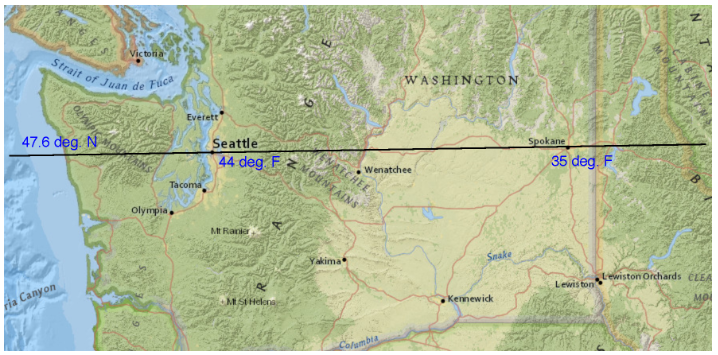9.2.1: ¿Qué influye en la temperatura?
- Page ID
- 118764
Lección
A ver si podemos predecir el clima.
Ejercicio\(\PageIndex{1}\): Temperature Changes
¿Qué factores o variables pueden influir en la temperatura exterior?
- Haz una lista de diferentes factores.
- Escribe una oración para cada factor describiendo cómo cambiarlo podría cambiar la temperatura.
Ejemplo: Un factor es la hora del día. A menudo, después del amanecer, la temperatura aumenta, alcanza un pico a primera hora de la tarde, y luego disminuye.
Ejercicio\(\PageIndex{2}\): Is Temperature a Function of Latitude?
1. Andre y Lin se preguntan si la temperatura es función de la latitud.
Andre dice: “Creo que lo es, siempre y cuando fijemos el tiempo en el que estamos midiendo la temperatura”.
Lin dice: “Pero, ¿y si tienes dos lugares con la misma latitud? Mira este mapa meteorológico del estado de Washington. Seattle y Spokane tienen la misma latitud pero temperaturas diferentes en este momento”.
¿Qué significan Andre y Lin?

2. Andre y Lin están discutiendo si es posible definir la latitud y la temperatura de una manera que tenga sentido hablar de la temperatura en función de la latitud. Están considerando diferentes opciones. ¿Cuáles son algunas ventajas y desventajas de cada opción?
Aquí están las opciones:
- Encontrar la temperatura ahora mismo en ciudades con diferentes latitudes.
- Encontrar la alta temperatura diaria en ciudades que tienen diferentes latitudes.
- Encontrar la temperatura alta promedio en un mes específico, por ejemplo, septiembre en ciudades que tienen diferentes latitudes.
- Encontrar la temperatura promedio anual en ciudades que tienen diferentes latitudes.
Ejercicio\(\PageIndex{3}\): Is There an Association Between Latitude and Temperature?
Lin y Andre decidieron que modelar la temperatura en función de la latitud en realidad no tiene sentido. Se dieron cuenta de que pueden preguntar si existe una asociación entre latitud y temperatura.
- ¿Qué información podrían reunir para determinar si la temperatura está relacionada con la latitud?
- ¿Qué deben hacer con esa información para responder a la pregunta?

